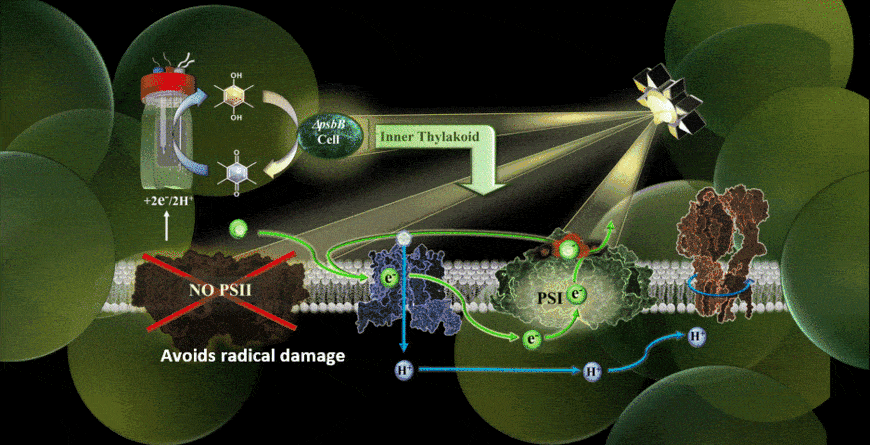
The world’s renewable energy capacity has increased tremendously in recent years and continues to do so at an encouraging rate. That’s good news for mankind’s mission to avert potentially catastrophic climate change, the biggest challenge of this century. The problem is that the rate of adoption of renewable energy is still not on the right track, partly because our insatiable demand for energy is also growing at a rapid pace. Playing this game of catch up requires us to put on our thinking hats and throw new clean technologies into the energy mix. And when faced with such challenges, it can be a good idea to turn to nature for inspiration.
With this in mind, researchers at Arizona State University have tapped into the natural processes that have allowed plants and many animals to draw their energy from the sun for more than a billion years. The team, led by graduate student Christine Lewis, devised a hybrid device — part battery, part living organism — that is capable of increasing energy flow from photosynthesis produced by bacteria. The researchers call this approach microbial electro photosynthesis or MEPS.
The proof-of-concept could eventually lead to new technologies fitting for a broad range of energy applications, such as transportation fuels, plastics, human and animal supplements, agrochemicals, and pharmaceuticals.
“This project involves unlocking the mysteries involved with energy transfer. Specifically, we work on bridging artificial energy with natural photosynthesis by tapping into the latter half of the photosynthetic electron transport chain,” Lewis said in a statement. “The research objectives are to have the ability to turn photosynthesis on at will, eventually to make it more efficient, and produce stable energy products.”
Tweaking nature
The evolution of photosynthesis on a large scale is one of the most significant events that shaped life on Earth. Not only did this process feed bacteria and plants that would then support entire ecosystems, but it also led to a massive increase in atmospheric oxygen levels, basically making our planet livable in the first place; oxygen that we and other complex life still breathe to this day.
Stripped to its bare bones, photosynthesis simply turns water, sunlight, and CO2 into energy that supports plant and bacterial growth. This natural process is possible thanks to two membrane-protein complexes called Photosystem I and Photosystem II, which work together to absorb and transfer electrons. The former’s main function is the production of a molecule called NADPH, while the latter is busy hydrolysis of water along with ATP synthesis (the energy currency of living cells made from glucose).
Scientists have tried to mimic these processes, developing so-called “artificial leaf” technologies that use sunlight to convert carbon dioxide into high-value compounds such as ethylene, methanol, and ethanol. But there are some problems.
While photosynthesis is very efficient at splitting water into hydrogen and oxygen — Photosystem II proteins in plants do this a thousand times a second, for instance — the rate at which light is converted into useful chemical energy is not suitable for the high-paced energy needs that our civilization requires.
One of the reasons why this is the case has to do with Photosystem II, which is disabled or outright destroyed when a photosynthetic organism is exposed to too many electrons at one time, such as when a plant is exposed to high-intensity sunlight.
Lewis and colleagues got around this problem by genetically modifying cyanobacteria that carry out photosynthetic cycling of electrons without a Photosystem II component. The bacteria is connected to the cathode of a battery, from which electrons are shuttled into the electron transport chain of the bacteria, with the help of some chemical mediators along the way.
As a result, the bacteria carry out photosynthesis, using the Photosystem I pathway, using an external power supply rather than energy from the sun. But the hybrid energy system also works with high-intensity light that would have been otherwise damaging.
The researchers envision a setup in which solar panels provide external power to photosynthetic reactors. Photovoltaic cells can harvest a much broader energy spectrum of light than bacteria or plants can, which are typically limited to red visible light. With the extra electrons, the modified bacteria can then perform their photosynthetic wonders on a much broader spectrum of light. In the future, this kind of hybrid photosynthesis could join established renewable sources, like solar and wind, to supplement our growing energy needs and replace dirty fossil fuels.
“By the year 2050, with global expansion moving at the pace that it is, our energy needs will surpass our supply. However, we can act now to learn how to provide efficient and cleaner energy,” Lewis says. “It is my goal to contribute to the next “breakthrough” that will help to make this big, blue marble a better place.”
The findings were reported in the Journal of the American Chemical Society.


